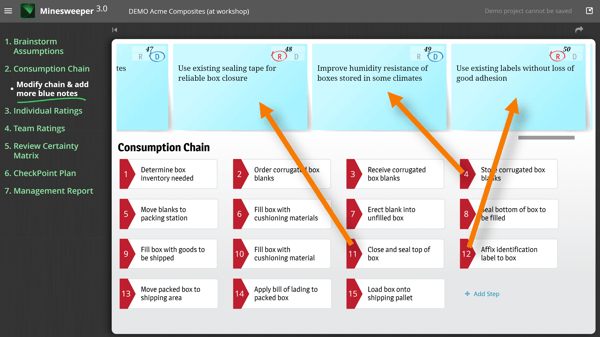Your consumption chain helps you think like your customers... to better imagine the needs you'll satisfy.
Why are you going to all this bother creating one or more consumption chain? It’s so you can create more assumptions that “must be true” for your project to succeed.
If you are trying to enter an unfamiliar market, it’s very easy to overlook how customers in this market do business today. The incumbent suppliers against whom you’ll compete may have developed many unspoken capabilities you might not consider. A consumption chain helps you think like the customers down your value chain so you can anticipate the requirements of your new product as early as possible.
Your team should look carefully at each step in your value chain and ask, “What must be true at this step?” As you think of new assumptions, you’ll click a blue “Customer Outcome” sticky note and record it.
Let’s see how this might work with our simulation, Acme Composite Packaging. The team might look at the following consumption chain steps and generate these new assumptions on blue sticky notes:
- Step 11, Close and seal top of box: “Use existing sealing tape for reliable box closure.”
- Step 4, Store corrugated box blanks: “Improve humidity resistance of boxes stored in some climates.”
- Step 12, Affix identification label to box: “Use existing labels without loss of good adhesion.”

If you think a customer outcome is something the customer would expect to keep getting—such as continuing to use their current sealing tape—record the assumption as a Required Outcome. If you think it’s something they would like to see you improve for them—such as better humidity resistance—record this as a Desired Outcome. In either case, you’ll investigate these to drive the assumption from uncertainty to certainty. As with earlier assumptions, try to keep these brief and clear.
Keywords: consumption chain, generate assumptions, incumbent suppliers, think like customer, blue sticky notes, customer outcomes, Required Outcome, Desired Outcome
